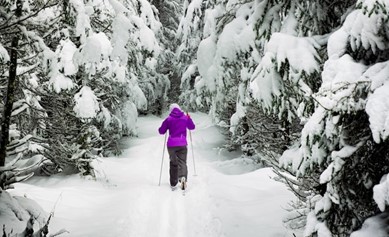Erica Hahn of Williamsburg, VA works in the pharmaceutical industry, and enjoys living a healthy lifestyle. In the following article, Erica Hahn reviews cold weather exercise, and how winter workouts can improve more than just physical health.
The winter months are notorious for banishing motivation for exercise and increasing the likelihood of people hunkering down in blankets, waiting for the warmer weather to return. But despite the body’s desire to stay wrapped up on the couch, heading outside for some cold weather activity is the best thing people can do for their not just their physical health, but their mental health as well.
Physical activity doesn’t need to stop because the temperate falls. In fact, colder climates boast distinct benefits over working out in the heat. With no humidity or blaring sun, Erica Hahn of Williamsburg, VA says that people can work out for longer, burning more calories while improving their immune systems.
The Importance of Exercise in Winter
The low levels of sunlight and shorter days that winter brings decreases the body’s Vitamin D exposure, draining energy stores and heightening feelings of fatigue or tiredness.
Plus, seasonal affective disorder (SAD) can run rampant, further increasing the desire to sleep or sit down more.
However, Erica Hahn explains that those who pull themselves off the couch to head into the frosty world and move their body can experience:
- increased optimism, despite the low light levels
- reduced fatigue
- boosted motivation
- decreased symptoms of depression, SAD, and anxiety
- more positivity
- enhanced life satisfaction
Activities such as ice skating, raking leaves, brisk walking or jogging, cross-country skiing, snowshoeing to shoveling snow, studies show that movement of any kind can help chase the winter blues away, and retain or improve physical and mental fitness.
Erica Hahn
Safety Is Key When Exercising in Cold Weather
Erica Hahn says that the outside landscape is a little different when the winter months roll around. And while it shouldn’t put people off outdoor activities, experts encourage a little preparation to ensure safety when out and about in the frost.
According to the National Weather Service, a 30-degree day with winds of 30 miles an hour feels like 15 degrees. Couple that with rain, or snow and the body’s perspiration, and it’s bound to feel even colder.
However, Erica Hahn of Williamsburg, VA says that avid exercisers have one foolproof tip for conquering that climate — layers. A few layers can go a long way to preventing winter hazards like frostbite and hypothermia.
Those getting outside to reinvigorate their minds, bodies, and souls should layer up with moisture-wicking materials utilized in high-performance sportswear, a fleece, and a thin waterproof jacket.
Erica Hahn encourages winter wanderers to leave cotton clothing at home. Any moisture will saturate it, leaving those braving the elements feeling colder and heavier.
Hydration, Hydration, Hydration
People may not feel as thirsty when exercising in cold weather, but that doesn’t mean they shouldn’t drink water. Staying hydrated is key, and the American Heart Association emphasizes the fact that feeling thirsty isn’t always the best indicator of dehydration.
 Bolstering Winter Safety by Understanding Hypothermia Signs
Bolstering Winter Safety by Understanding Hypothermia Signs
Children and the elderly are more at risk of hypothermia because they may have impaired mobility, less subcutaneous fat, or a minimized ability to detect temperature. However, everyone living in particularly cold areas should understand the signs of hypothermia to better protect themselves and their loved ones during outdoor adventures.
Erica Hahn reports that the medical professionals at the American Heart Association note the following as common symptoms of hypothermia:
- Sleepiness
- Cold feet and hands
- Slowed reaction speeds
- Mental confusion
- Lack of coordination
- Shivering
- Slurred speech
Staying Fit Inside the Home
While heading into the great outdoors when there’s frost on the trees is an invigorating experience, there are times when outside workouts aren’t possible. But that doesn’t mean exercisers need to revert to hibernating on the couch. Instead, Erica Hahn says that people can move inside their homes, getting in some physical exercise while improving mental well-being.
From dancing to home workout videos to yoga sessions to roller skating to climbing the stairs to active housework, there are plenty of options for physical indoor movement.
Winter Exercise for Mental and Physical Well-Being
The population can massively benefit from moving their bodies, even when the weather saps motivation and leaves them unknowingly yearning for Vitamin D.
Erica Hahn of Williamsburg, VA reports that people should prioritize physical activity over couch sitting and TV watching over the winter, ensuring they benefit from the tremendous mental and physical health impacts.
While colder climates might not be loved by the masses, they shouldn’t stop anybody from getting the recommended 150 minutes of aerobic exercise per week.
Despite popular belief, winters are for moving.







